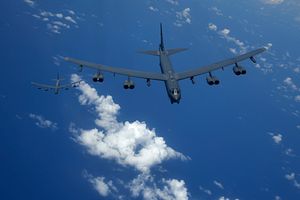The United States flew nuclear-capable bombers to the Korean Peninsula on Friday in its latest show of force against North Korea, days after the North staged massive anti-U.S. rallies in its capital.
The long-range B-52 bombers took part in joint aerial drills with other U.S. and South Korean fighter jets over the peninsula, South Korea’s Defense Ministry said in a statement. The bombers’ flyover is the latest in a series of temporary U.S. deployments of strategic assets in South Korea in response to North Korea’s push to expand its nuclear arsenal.
Two weeks ago, the United States deployed a nuclear-powered submarine capable of carrying about 150 Tomahawk missiles to South Korean waters for the first time in six years. The USS Michigan’s arrival came a day after North Korea resumed missile tests to protest previous U.S.-South Korean drills that it views as an invasion rehearsal.
The South Korean Defense Ministry said the B-52 bombers’ deployment boosted the visibility of U.S. strategic assets to the peninsula. It said the allies have been demonstrating their firm resolve to strengthen combined defense postures and will continue joint drills involving U.S. strategic bombers.
On Sunday, more than 120,000 North Koreans participated in mass rallies in Pyongyang to mark the 73rd anniversary of the start of the Korean War. During the rallies, officials and residents delivered speeches vowing “merciless revenge” against the United States over the war while accusing the U.S. of plotting an invasion on North Korea.
The Korean War ended with an armistice, not a peace treaty, leaving the peninsula in a technical state of war. The United States stations about 28,000 troops in South Korea as deterrence against potential aggression by North Korea.
Since its June 15 launches of two short-range ballistic missiles, North Korea hasn’t performed any further public weapons tests. But the U.S. bombers’ deployment could prompt it to launch weapons again in protest.
Enhancing “regular visibility of U.S. strategic assets” to the Korean Peninsula was part of agreements reached between U.S. President Joe Biden and South Korean President Yoon Suk-yeol during their summit in Washington in April. Biden stated at the time that any North Korean nuclear attack on the U.S. or its allies would “result in the end of whatever regime” took such action.
Since the start of 2022, North Korea has carried out more than 100 missile tests in a bid to enlarge its arsenal of nuclear-capable missiles targeting the U.S. mainland and South Korea. The allies have responded by expanding their military exercises.
In late May, a North Korean launch of a rocket carrying its first spy satellite ended in failure, with the rocket plunging into waters soon after liftoff. North Korea has since repeatedly said it would attempt a second launch, saying it’s crucial to build space-based surveillance system to cope with what it calls U.S. hostility.

































